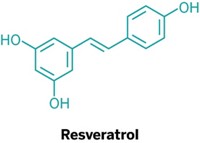Advertisement
Grab your lab coat. Let's get started
Welcome!
Welcome!
Create an account below to get 6 C&EN articles per month, receive newsletters and more - all free.
It seems this is your first time logging in online. Please enter the following information to continue.
As an ACS member you automatically get access to this site. All we need is few more details to create your reading experience.
Not you? Sign in with a different account.
Not you? Sign in with a different account.
ERROR 1
ERROR 1
ERROR 2
ERROR 2
ERROR 2
ERROR 2
ERROR 2
Password and Confirm password must match.
If you have an ACS member number, please enter it here so we can link this account to your membership. (optional)
ERROR 2
ACS values your privacy. By submitting your information, you are gaining access to C&EN and subscribing to our weekly newsletter. We use the information you provide to make your reading experience better, and we will never sell your data to third party members.
Biological Chemistry
Time In A Bottle
An exploration of antiaging science and the possibility that it will realize its full potential
by Laura Cassiday
August 23, 2010
| A version of this story appeared in
Volume 88, Issue 34

Throughout history, humans have exercised very little control over their own life spans. It’s no wonder the ancient Greeks imagined that the whim of the Fate Lachesis determined the length of life’s thread. In reality, a potpourri of genes, lifestyle, and plain old luck decides our time on Earth. Yet the U.S. obsession with nutritional supplements, wrinkle creams, Botox, and Viagra indicates that most of us are not willing to “go gentle into that good night,” to quote poet Dylan Thomas, but rather must be dragged kicking and screaming.
Although advocates of antiaging products were once regarded as snake-oil-peddling charlatans, scientists’ improved understanding of the aging process now offers the best hope ever for extending healthy life span. In “The Youth Pill: Scientists at the Brink of an Anti-Aging Revolution,” David Stipp, former staff reporter for the Wall Street Journal, details the enduring quest to encapsulate the Fountain of Youth—a journey rife with wrong turns and near-misses, but with the siren song of immortality forever beckoning.
In witty and engaging prose, Stipp chronicles the history of the gerontology field and its decades-long rise from ridicule to respectability. With their reputations tarnished by physician-endorsed “antiaging” remedies of the late-19th and early-20th centuries (including, among others, surgical implantation of ape testicular grafts into thousands of elderly men), scientists who studied aging were often considered quacks or fools.
Indeed, understanding the tangled web of biological events that cause us to gray, wither, and succumb to age-related illnesses seems almost like a fool’s quest. But beginning in the 1930s, many scientists began to view aging as something other than a haphazard process of wear and tear: Maybe, just maybe, it has an evolutionary basis.
Through colorful vignettes and amusing anecdotes, Stipp introduces the reader to pioneers of the gerontology field and explains how their ideas coalesced to produce the modern view of aging. One such revolutionary thinker was Nobel Laureate Peter B. Medawar, a zoology professor at the University of London. In 1951, Medawar proposed that natural selection, in effect, kicks us to the curb after we can no longer procreate. Because young organisms are the ones who transmit genes to offspring, there’s no evolutionary benefit to having a superlong life span. According to Medawar, aging occurs because evolution is indifferent to harmful genetic mutations that accumulate after reproductive age, and the odds of such mutations occurring increase with age.
A few years later, American biologist George C. Williams expanded on Medawar’s ideas to formulate the “antagonistic pleiotropy” theory of aging. Williams posited that pro-aging genes don’t just crop up randomly in the genome, as Medawar suggested. Rather, such genes are selected by evolution because they provide a survival advantage during youth. In other words, genes that help young organisms stay healthy and reproduce can turn against them in old age. An example is a hypothetical gene that helps calcify bones during development, but later in life calcifies artery walls and contributes to heart disease. Tying into Medawar’s theory, evolution wouldn’t care about these negative late-acting effects because the two-faced gene would have already served its purpose: allowing the organism to reproduce. Or as Williams put it, evolution “may be said to be biased in favor of youth over old age whenever a conflict of interest arises.”
Is there any hope for combating evolutionary ageism with wonder drugs? Williams didn’t think so because targeting any one pro-aging gene with a drug would be like the little Dutch boy who plugs a leak in the dike with his finger, while hundreds of other leaks spring up all around him. In other words, there are just too many genes that go rogue during aging to ever hope to reverse the process as a whole.
Yet in the 1980s and ’90s, scientists discovered that, far from being set in stone, aging is a remarkably plastic process that can be dramatically slowed in model organisms by mutating single “master regulator” genes. In 1993, Cynthia Kenyon, a professor of biochemistry and biophysics at the University of California, San Francisco, showed that mutating one such gene, known as daf-2, in Caenorhabitis elegans could more than double the nematodes’ life spans. The daf-2 gene was already known by worm researchers to be involved in “dauer formation,” a kind of suspended-animation state that larval nematodes enter when food is scarce.
When Gary Ruvkun, a professor of genetics at Harvard University, noticed that the daf-2 gene resembles two mammalian genes (the insulin and insulin-like growth factor 1 hormone receptors), the discovery sent shock waves throughout the scientific and popular presses. For the first time, it seemed conceivable for scientists to tinker with human life span as well. Although daf-2-like mutations in humans have dire consequences (leprechaunism, a rare syndrome that stunts growth and is usually fatal in childhood), dialing down the expression of human daf-2-like genes or influencing the activities of other aging-related genes might replicate the worm Methuselah effect.
Another way to lengthen the lives of lab animals is calorie restriction (CR), a near-starvation diet that dramatically increases the life span of nematodes, fruit flies, mice, rats, and quite possibly monkeys (primate studies are ongoing, but preliminary results are promising). Like daf-2 mutation, CR triggers strong survival responses that help organisms survive famine to reproduce in better times. The animals become resistant to age-associated diseases such as cancer and diabetes, appear sleeker and friskier than their well-fed peers, and survive up to 50% longer. Although some people are applying these findings to their own lifestyles, many of us lack the willpower and question whether a lifetime of deprivation is worth the possibility of a few extra years.
However, the amazing ability of CR to stave off disease and slow aging has galvanized gerontologists and biotech companies to uncover the mechanisms behind the phenomenon and to develop drugs that mimic CR’s rejuvenating effects. Stipp provides behind-the-scenes accounts of the meteoric rise of Sirtris Pharmaceuticals, a company cofounded by Harvard biologist David Sinclair that built upon research indicating a pivotal role for sirtuins—energy-sensing proteins that silence pro-aging genes—in CR. In 2003, Sinclair published his finding that resveratrol, a polyphenol compound famously found in red wine, activates yeast sirtuins to mimic CR. Although some scientists have since questioned the link among sirtuins, CR, and resveratrol, the compound confers health benefits in mice such as improved motor and cardiovascular function in old age. In contrast to CR, resveratrol doesn’t increase a mouse’s normal life span, but this hasn’t stopped the popular press, winemakers, and nutraceutical firms from heralding resveratrol as “the Fountain of Youth drug.”
In fierce competition with Elixir Pharmaceuticals, founded by Sinclair’s former Massachusetts Institute of Technology postdoctoral adviser, Leonard P. Guarente, Sirtris researchers worked at a feverish pace to develop potent, patentable sirtuin activators. Because the Food & Drug Administration does not recognize aging as a disease, human clinical trials of resveratrol and related compounds must target specific diseases of aging such as cancer or diabetes—any antiaging properties of the drugs will likely emerge only as side benefits after years go by. Less than two years after opening its doors, Sirtris began clinical testing of SRT501, a proprietary form of resveratrol with improved bioavailability, in patients with multiple myeloma. The company also identified novel sirtuin activators 1,000 times more potent than resveratrol that mimic some aspects of CR in mice. Two of these are currently in Phase I and II clinical trials for metabolic, inflammatory, and cardiovascular diseases. In 2008, pharmaceutical giant GlaxoSmithKline acquired Sirtris for $720 million, an astonishing sum considering that sirtuin activators were—and still are—largely unproven.
Gerontologists’ thirst for CR mimetics intensified with the 2009 discovery that rapamycin, an antibiotic identified in soil samples from Easter Island, lengthens the normal life span of mice, even when administered to middle-aged mice. The drug targets a nutrient-sensing protein aptly identified as the target of rapamycin (TOR), which is increasingly thought to underlie the effects of CR. Rapamycin reduces the risk of heart disease, age-related bone loss, neurodegenerative disease, and cancer in mice and has been administered for years as an immunosuppressant to human recipients of organ transplants. The downside: In people, rapamycin may slow wound healing, alter brain function, and suppress the immune system. Although rapamycin in its current form is therefore an unlikely antiaging drug, scientists may someday be able to tweak its molecular structure to obtain longevity benefits without side effects.
After conducting voluminous research on antiaging medicines, does Stipp plan to start popping youth pills anytime soon? For now, he’s holding off on resveratrol supplements until scientists determine the optimal dosage for CR-like effects. Until then, the author is taking the middle road by trying to incorporate foods in his diet that activate CR-related pathways. Resveratrol is found not only in red wine, but also in dark chocolate, cherries, and peanuts, whereas aspirin and coffee can alter TOR activity. But this approach to slowing aging seems a bit like trying to extinguish a raging inferno by spitting on it. For example, to ingest enough resveratrol to equal the beneficial dose in mice, the average person would have to down 300 glasses of wine per day.
Even if, as Stipp believes, scientists are on the brink of an antiaging revolution, is extending human life span really a wise thing to do? Wouldn’t an army of “greedy geezers” burden social services, destroy the economy, and deplete Earth’s dwindling resources? Stipp rejects these ideas, citing evidence that as a nation’s life expectancy increases, so do productivity and per capita income, whereas the birthrate declines. Moreover, seasoned citizens offer benefits that society can’t put a price tag on, such as experience, wisdom, and a strong work ethic. However, the picture isn’t all rosy: Increased life expectancy would undoubtedly require Social Security reform and a boost to the average retirement age. And it’s not a given that CR mimetics would ensure a speedy, pain-free demise once our time finally runs out—they could just delay our languishing from cancer or Alzheimer’s disease until a later age.
Yet as the obesity epidemic sweeps America and even children are being diagnosed with “old people’s diseases” such as type 2 diabetes and atherosclerosis, it’s possible that CR mimetics will be needed simply to prevent the nation’s first decline in life expectancy in almost two centuries. While many people eagerly await an elusive longevity-boosting wonder drug, the most reliable, if unpopular, antiaging remedy continues to be a healthy lifestyle.






Join the conversation
Contact the reporter
Submit a Letter to the Editor for publication
Engage with us on Twitter